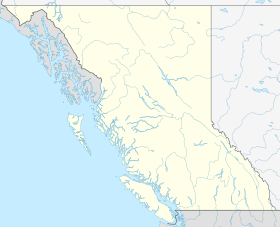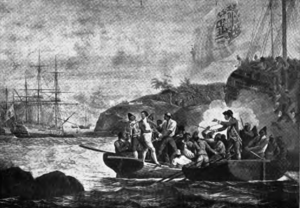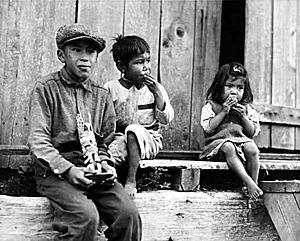Santa Cruz de Nuca facts for kids
Quick facts for kids Santa Cruz de Nuca |
|
|---|---|
| Yuquot, British Columbia, Canada | |
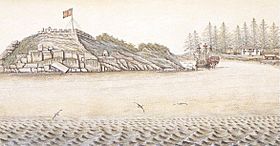
Reconstruction of Fort San Miguel and Santa Cruz de Nuca
|
|
| Coordinates | 49°35′38″N 126°37′12″W / 49.594°N 126.62°W |
| Type | Colonial fortification |
| Site information | |
| Controlled by | Spanish Empire |
| Site history | |
| Built | 1789 |
| In use | 1789–1795 |
| Garrison information | |
| Past commanders |
Pedro de Alberni |
Santa Cruz de Nuca was a Spanish fort and settlement. It was the first European colony in what is now British Columbia, Canada. The settlement was built on Vancouver Island in 1789. It was left in 1795. This fort was the furthest north the Spanish ever settled in North America. Spain wanted to claim the entire west coast from Alaska southwards.
However, many British fur trading ships were in the area. This made Spain's plan to claim the whole coast fail. The colony was briefly left empty between October 1789 and April 1790. In 1795, it was permanently abandoned after an agreement called the Nootka Convention was signed. After this, the Spanish missions near San Francisco Bay were their most northern settlements in western North America.
The Nootka Convention helped solve fights that almost led to war between Britain and Spain. This conflict was known as the Nootka Crisis. The fort of Santa Cruz de Nuca was protected by Fort San Miguel. Santa Cruz de Nuca was the only Spanish settlement confirmed to be in what is now Canada. Some old Spanish maps showed other settlements, but these were likely just made up to stop other countries from expanding there.
Contents
Early history of Yuquot (until 1778)
Yuquot means "Wind comes from all directions." It was the summer home for many generations of the Mowachaht/Muchalaht people. They are part of the Nuu-chah-nulth nation. About 1,500 people lived in 20 traditional wooden longhouses there.
Captain James Cook visited Nootka Sound in 1778. This was the second time Europeans had seen Yuquot. The first was Juan José Pérez Hernández in 1774.
European explorations and settlement (1778–1800s)
New Spain (which was a Spanish territory) claimed the entire west coast of North America. So, when Russian fur traders started working in Alaska in the late 1700s, Spain saw it as an invasion. Also, when James Cook of the British Navy explored the northwest coast, and British ships started trading fur, Spain felt their land was being taken.
To protect their claim, New Spain sent many expeditions to the Pacific Northwest between 1774 and 1793.
In 1789, the Viceroy of New Spain, Manuel Antonio Flórez, told Esteban José Martínez to take control of Nootka Sound. This area is on Vancouver Island in today's British Columbia. Martínez was told to build a settlement and a fort there. This was to show that Spain was officially establishing its presence.
The Russians were thinking of taking Nootka Sound. Also, in May 1788, a British fur trader named John Meares had used Nootka Sound as a base. He claimed he bought land there from the local Nuu-chah-nulth people. John Meares, sailing under false papers, explored Nootka Sound. He claimed to have bought land from a chief named Maquinna and built a trading post. However, these claims were later proven false by George Vancouver in 1792.
First establishment of Santa Cruz de Nuca and Fort San Miguel
In 1789, Spanish commander Esteban José Martínez arrived at Nootka Sound on May 5. Spain already considered this land part of New Spain because of earlier explorations. On May 15, 1789, Martínez chose a spot for his fort and settlement. It was at the entrance of Friendly Cove (Yuquot) on Hog Island.
By May 26, they had placed their cannons. Then they built barracks and a place to store gunpowder. The new Santa Cruz de Nuca settlement had houses and a hospital.
During the summer of 1789, several fur trading ships, both British and American, came to Nootka. The American captains listened to warnings and left. On June 24, 1789, the new fort and Spanish ships fired their cannons. Martínez saw this as an official act of taking possession of Nootka Harbour. On July 4, American ships fired cannons and fireworks to celebrate their independence from Britain. The Spanish fort also fired a salute.
On July 29, 1789, Martínez received new orders. He was told to leave Fort San Miguel and return to San Blas. The cannons were put back on the ship Princesa Real. Martínez left Friendly Cove on October 30, 1789. The fort was taken apart, but Martínez buried bricks and lime, hoping to come back later.
Nootka Crisis
Martínez arrived at Nootka Sound on May 5, 1789. He found three ships there: two American and one British, the Iphigenia. He seized the Iphigenia and arrested its captain, William Douglas. A few days later, Martínez released Douglas and his ship, telling him not to return. Douglas obeyed.
On June 8, the North West America arrived and was seized by Martínez. This ship was renamed Santa Gertrudis la Magna. It was used to explore the region, sailing far into the Strait of Juan de Fuca. Martínez later claimed the captain had abandoned the ship. He also said he seized it as security for money owed by the ship's company for supplies.
On June 24, Martínez officially claimed the entire northwest coast for Spain. This was done in front of the British and Americans present at Nootka Sound.
On July 2, the British ships Princess Royal and Argonaut arrived. Martínez ordered the Princess Royal's captain to leave. When the Argonaut arrived, Martínez seized it and arrested its captain, Colnett, his crew, and Chinese workers. The Argonaut also carried equipment. Colnett said he planned to build a settlement at Nootka Sound, which Martínez saw as breaking Spanish rules.
Martínez then used the Chinese workers to build Fort San Miguel and improve the Spanish post. The Argonaut also had materials for building a new ship. These materials were used to improve the Santa Gertrudis la Magna. This ship was later taken to San Blas, taken apart, and its pieces brought back to Nootka Sound in 1790. These pieces were used to build a new ship called Santa Saturnina. This ship was used to explore the Strait of Georgia in 1791.
On July 12, the Princess Royal returned. It was calm, so the ship couldn't move. Martínez saw this as a challenge and seized the ship.
The Nuu-chah-nulth people, who lived at Nootka Sound, watched the disputes. On July 13, a Nuu-chah-nulth leader named Callicum, son of Maquinna, met with Martínez. Callicum seemed angry, and he was shot and killed. It's not clear exactly how it happened. Some say Martínez fired a warning shot, and another sailor, thinking Martínez missed, fired and killed Callicum. Others say Martínez aimed at Callicum, his gun misfired, and another sailor fired. The reason for Callicum's anger is also debated. This event created a bad relationship between the Spanish and the Nuu-chah-nulth. Maquinna, fearing for his life, moved his people from Yuquot to Aoxsha.
On July 14, the Argonaut sailed to San Blas with a Spanish crew and Colnett and his crew as prisoners. Two weeks later, the Princess Royal followed.
American ships, the Columbia Rediviva and the Lady Washington, were in the area all summer. Martínez left them alone, even though he was supposed to stop any nation's ships from trading at Nootka Sound. The captured crew of the North West America was sent to the Columbia before the Americans sailed to China.
Two other American ships arrived later. The Fair American was captured by Martínez. Its sister ship, the Eleanora, almost got captured but escaped.
On July 29, 1789, a Spanish supply ship arrived with orders to leave Nootka Sound by the end of the year. By the end of October, the Spanish had completely left Nootka Sound. They returned to San Blas with the Princess Royal, Argonaut, and Fair American as captured ships. The Fair American was released in early 1790. The Nootka Incident did not cause a major problem between the United States and Spain.
Second establishment of Santa Cruz de Nuca and Fort San Miguel
By late 1789, a new viceroy, Juan Vicente de Güemes, 2nd Count of Revillagigedo, took over. He wanted to keep defending Spain's claims in the area. Martínez, who had been liked by the old viceroy, became a scapegoat under the new one.
In 1790, a new Spanish expedition led by Francisco de Eliza came back to Nootka Sound. Later, Alessandro Malaspina visited in 1791. Juan Francisco de la Bodega y Quadra then worked on carrying out the Nootka Conventions in 1792. Juan Francisco de la Bodega y Quadra, a senior commander, replaced Martínez in charge of Nootka Sound. A new expedition was sent, and in early 1790, the Spanish reoccupied Nootka Sound under Francisco de Eliza. This was the largest Spanish force sent to the northwest yet.
Some months later, Manuel Antonio Flórez, the former Viceroy of New Spain, ordered Francisco de Eliza to rebuild and enlarge the fort and settlement. The expedition had three ships. They sailed from San Blas in early 1790 and arrived at Nootka Sound in April. The expedition included 80 Catalan volunteers led by Pere d'Alberní.
They rebuilt the fort, which had been taken apart. The new fort had several defenses and a vegetable garden for food. The colony was quite large, with houses, a brewery (the first in British Columbia), a hospital, and a governor's house.
Three lines of defense were set up: the frigate Concepción, soldiers on land and on the frigate, and the rebuilt battery on San Miguel Island. Building the battery was hard because it was on a tall, small, rocky island. They had to build openings for the guns. It took four days to place eight large cannons. Later, six smaller cannons were added. There wasn't enough space for all the cannons Eliza brought, so some were stored ashore.
Another outpost was partly built at Neah Bay in what is now Washington. It was meant to replace Santa Cruz de Nuca. It was abandoned in 1792 before it was finished. Its people, animals, cannons, and ammunition were moved to Nuca.
When news reached London in January 1790, Britain demanded payment. Spain refused. Both sides got ready for war and looked for allies. The crisis was solved peacefully through three agreements, called the Nootka Conventions. Spain agreed to share some rights to settle along the Pacific coast but kept its main claims. This was seen as a win for British trade and opened the way for British expansion in the Pacific. However, Spain continued to settle the Pacific coast, especially in today's California, until 1821.
In April 1790, John Meares arrived in England. He confirmed rumors and claimed he bought land and built a settlement at Nootka before Martínez. This made anti-Spanish feelings grow. In May, the issue was discussed in the House of Commons. The Royal Navy started preparing for war. An ultimatum was sent to Spain.
Meares published his Voyages in 1790, which became very popular during the Nootka Crisis. Meares not only described his trips but also imagined a new trade network in the Pacific. This network would connect places like the Pacific Northwest, China, Japan, Hawaii, and England. This idea tried to copy Spain's old trade networks, like the Manila galleons and Atlantic treasure fleets, which had linked Asia and North America since the 1500s. Meares strongly argued for less control by the East India Company and the South Sea Company, which controlled all British trade in the Pacific. His vision eventually happened, but only after the long Napoleonic Wars ended.
Both Britain and Spain sent strong fleets of warships towards each other. There was a chance of war if they met, but they did not.
Nootka Conventions
The first Nootka Convention, called the Nootka Sound Convention, generally solved the crisis. It said that the northwest coast would be open to traders from both Britain and Spain. The captured British ships would be returned, and Spain would pay for them. It also said that the land owned by the British at Nootka Sound would be given back. This was hard to do. Spain claimed the only land was a small piece where Meares built his ship. Britain said Meares had bought all of Nootka Sound from Maquinna, plus some land to the south.
Until the details were worked out, which took several years, Spain kept control of Nootka Sound and the fort. The role of the Nuu-chah-nulth people also changed. They became very suspicious of Spain after Callicum was killed in 1789. But the Spanish worked hard to improve their relationship. By the time the Nootka Conventions were carried out, the Nuu-chah-nulth were mostly allied with the Spanish. This happened a lot because of Alessandro Malaspina and his officers during his month-long stay at Nootka Sound in 1791. Malaspina was able to regain Maquinna's trust. Maquinna promised that the Spanish had the right to own land at Nootka Sound.
Negotiations between Britain and Spain were supposed to happen at Nootka Sound in the summer of 1792. Juan Francisco de la Bodega y Quadra came for Spain. The British negotiator was George Vancouver, who arrived on August 28, 1792.
Vancouver and Bodega y Quadra were friendly, but their talks were difficult. Spain wanted the border between Spanish and British land to be at the Strait of Juan de Fuca. But Vancouver insisted on British rights to the Columbia River. Vancouver also didn't like the new Spanish post at Neah Bay. Bodega y Quadra insisted Spain keep Nootka Sound, which Vancouver couldn't accept. In the end, they agreed to let their governments decide.
By 1793, Britain and Spain became allies in a war against France. The Nootka Crisis issues became less important. An agreement was signed on January 11, 1794. Both nations agreed to leave Nootka Sound. There was a ceremony to transfer the post at Friendly Cove to the British.
The official transfer happened on March 28, 1795. General Álava represented Spain, and Lieutenant Thomas Pearce represented Britain. The British flag was raised and then lowered. Afterwards, Pearce gave the flag to Maquinna and asked him to raise it whenever a ship appeared.
Under the Nootka Convention, Britain and Spain agreed not to build any permanent bases at Nootka Sound. However, ships from either nation could visit. The two nations also agreed to stop any other country from claiming control there.
The Nootka Conventions of the 1790s, partly carried out by George Vancouver and Juan Francisco de la Bodega y Quadra, stopped the dispute from becoming a war. The first Convention was signed on October 28, 1790. It was intentionally vague. It said that all "buildings and tracts of land" at Nootka Sound seized by Martínez would be given back to Britain. Vancouver and Bodega y Quadra were sent to Nootka Sound in 1792 for this purpose. However, no buildings had been seized. Bodega said no land had been bought by the British. Chief Maquinna and American traders Robert Gray and Joseph Ingraham, who were there in 1789, also agreed. Vancouver would not accept Bodega's offers, so the matter was sent back to the British and Spanish governments.
First Nootka Convention
The first Nootka Convention is important in the Falkland Islands sovereignty dispute between the United Kingdom and Argentina. Article VI said that neither side would build new settlements on any islands near the east and west coasts of South America that Spain already occupied. Both could still land and build temporary structures for fishing. However, a secret article said that Article VI would only last as long as no other country built settlements on those coasts. This secret article had the same power as if it were in the main convention. How the Nootka Convention applies to the Falklands dispute is debated. The United Provinces of the Río de la Plata was not part of the convention. So, if they occupied a settlement (at Port Louis), it would cancel Article VI. This would allow Great Britain to claim its earlier rights and build new settlements.
Second Nootka Convention
The second Nootka Convention, also called the Nootka Claims Convention, was signed in February 1793. It gave money to John Meares because Spain had seized his ships at Nootka in 1789.
Third Nootka Convention
The third Nootka Convention, also known as the Convention for the Mutual Abandonment of Nootka, was signed on January 11, 1794. It called for both countries to leave Nootka Sound. Britain and Spain could both use Nootka Sound as a port and build temporary structures. But, "neither ... shall form any permanent establishment in the said port or claim any right of sovereignty or territorial dominion there to the exclusion of the other." Also, they would help each other keep free access to Nootka port against any other nation trying to claim control there.
Nootka Convention and the abandonment of Santa Cruz de Nuca
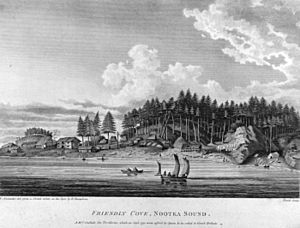
The Nootka Conventions are sometimes described as Spain agreeing to leave the northwest coast, but this was not a requirement.
In a bigger picture, the Nootka Conventions showed that a country could not just claim land without actually settling it. It was not enough to claim territory just because the Pope granted it, or by being the "first to discover" it. Claims had to be supported by actually occupying the land.
The outcome of the crisis was a defeat for Spain and a victory for Britain. Spain basically gave up all its claims to the North Pacific coast. The British did not win everything they wanted. Their merchants were still stopped from trading directly with Spanish America. No northern border for Spanish America was set. Still, after the Nootka Crisis, Britain became the most powerful country in the Pacific.
Spanish rights in the Pacific Northwest were later taken over by the United States through the Adams–Onís Treaty, signed in 1819. The United States said it got full control from Spain. This became a key part of the American position during the Oregon boundary dispute. To argue against the US claim, the British mentioned the Nootka Conventions. This dispute was not solved until the Oregon Treaty in 1846. That treaty divided the disputed land and set what is now the border between Canada and the United States.
The first Nootka Convention stopped the war but left many issues unsolved. Both sides wanted to define a northern border for New Spain. At Nootka Sound, Spain's representative, Juan Francisco de la Bodega y Quadra, suggested a border at the Strait of Juan de Fuca. But the British representative, George Vancouver, refused any border north of San Francisco. No agreement was reached. The northern border of New Spain remained unclear until the Adams–Onís Treaty with the United States in 1819. That treaty also gave Spanish Florida to the United States.
The Catalan volunteers left the fort in 1792. Spanish influence in the region ended in 1795 after the third Nootka Convention took effect. Santa Cruz de Nuca was finally abandoned.
Modern era
Before Spain occupied it, the site was the Mowachaht summer village of Yuquot. It was reoccupied by the Mowachaht under Chief Maquinna. Parts of the Spanish post, like its garden, were still visible when John R. Jewitt, an English captive of Maquinna, lived there from 1803-1805.
Today, Yuquot (or Friendly Cove) is a small settlement with fewer than 25 people. The Canadian government declared Yuquot a National Historic Site in 1923. The importance of the First Nations history there was recognized in 1997. Efforts are being made to add Yuquot/Santa Cruz de Nuca as a British Columbia Provincial Historic Site.
See also
 In Spanish: Santa Cruz de Nuca para niños
In Spanish: Santa Cruz de Nuca para niños


